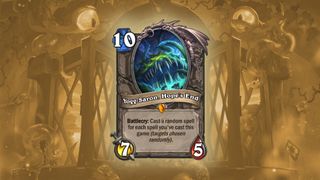
PCG: Is there anything specific you’d like to see when we come to the next Standard rotation? You’ve talked about the notion of a core set. What would you do if you were in charge?
Kibler: I’d like to see more of a shift in terms of the contents of the set that is the baseline for the Standard format. For instance, one of the reasons that I think Priest is quite weak currently in Standard, is that so many of Priest’s cards in the Classic set are just not good. A lot of Priest cards are balanced around the visceral emotional response people have to getting their stuff stolen, as opposed to the actual numbers and how powerful a card is in an objective sense. Balancing to players’ feelings is important, but the problem comes when that is such a core part of the class identity that is preserved forever, as part of the bedrock of the Standard format.
Similarly, while I think that decks like Miracle Rogue and Freeze Mage are cool, and it’s interesting that they exist, I think it is less interesting if they exist forever, because then they become this cornerstone of decks that you have to be able to beat with your deck. I think a huge part of the reason we see so many aggressive decks in tournament play is because Freeze Mage and Miracle Rogue are very popular and powerful tournament decks. In order to compete with them, in many cases you have to be able to proactively beat them down before they can win. They create this framework of restriction on what decks are realistically viable.
PCG: I definitely don’t want to still be watching Miracle Rogue in five years.
Kibler: Miracle Rogue in 2018 EleGiggle.
PCG: Hearthstone is tremendously successful. Do you think it’s reached the point where it will become hard for other CCGs to challenge it, in the same way that it’s hard—as Heroes of the Storm has found—for new MOBAs to challenge DOTA 2 and League?
Kibler: I think that Hearthstone has widened the CCG market enormously. It has exposed tons of people who never would have played something like Magic: the Gathering, and gotten them interested in that category of games. I think that there’s enough room in terms of variation in the kind of things you can do with a collectible game, that it won’t just be, “I could play Hearthstone instead of this.” If there’s a game that has a unique twist on the style of a collectible game, that’s still something that could easily be very appealing to a big audience, who may not have even considered trying that before.
PC Gamer Newsletter
Sign up to get the best content of the week, and great gaming deals, as picked by the editors.
PCG: The guys at CD Projekt Red with their Gwent standalone game announced that when you open the packs you’ll get to pick—almost like the Discover mechanic—which rare you want. Do you think that puts pressure on Hearthstone?
Kibler: I think any time you say, hey we’re going to make it easier for you to get the stuff that you want, people say, “Yes! I like that!” But frankly, I think the card acquisition model in Hearthstone is fantastic. There’s enough moments of excitement because you get what you want, and it’s easy enough to get the things that you want when you don’t get them, because the crafting mechanic is very friendly to players. So I don’t think there’s a push for Hearthstone to make a change in that way.
PCG: What’s the long term plan for you in Hearthstone? Can you see yourself branching out into other genres?
There was a point where just Yogg happening was exciting to anyone. Now it’s kind of an arms race of Yogging.
Kibler: [Laughs] I’m too bad at other games to be able to draw an audience playing. I like a lot of games, but games like Overwatch or League of Legends I’m just not... the kind of skills that I have from playing card games for so many years don’t translate to that kind of game. I will occasionally have people who ask me to stream other games, but generally I find that because my expertise is in the card game category, I have the most success, at least in terms of keeping an audience, by streaming games in that niche.
PCG: I remember when you first started streaming, you were going for HCT points and competing in some tournaments. Is that off the table now?
Kibler: For one, I really enjoy doing the broadcasting for the HCT events. It’s a lot of fun, and being able to see both the scene and the storylines of everything evolve from behind the scenes is great. And also, not focusing on competitive play allows me to play stuff that I enjoy more on my stream, and frankly that my audience seems to enjoy more. People would kind of riot in my stream if I were like, “Today I’m going to play eight hours of Tempo Warrior.” They’d be like, “Can you at least put a Yogg in it?” That works out for me, because it means I get to do what I enjoy, which is experiment and tinker with different decks, and what my audience seems to enjoy, which is play decks that cause crazy and fun situations to come up—and that are way more exciting for YouTube highlights too.
PCG: So you’re saying you don’t want to be playing Aggro Shaman on New Year’s Eve trying to get those last few points?
Kibler: That’s about the last thing I want to do. [Laughs]

PCG: Yogg has been a big draw for entertainment streams, to the point that people would rather see you lose as long as you Yogg. Do you think the Yogg hype will fade?
Kibler: There was a point where just Yogg happening was exciting to anyone. Now it’s kind of an arms race of Yogging. In order for a highlight to be exciting now, some really wacky things have to happen with this Yogg. I think that the Old Gods in general tend to lend themselves to the kind of decks that both I enjoy and that audiences seem to enjoy, because they generally build up to big exciting things at the end of the game—which I think is great structurally from the perspective of the goals of the expansion. Yes, there may be Aggro Shaman and Zoo decks that are making up a huge percentage of the metagame, but there is still this push to play these really powerful and exciting late game Legendary cards, and I think that’s really cool.
PCG: Do you think there will be a pressure on Blizzard to keep one-upping themselves with each new set? We had Thaurissan, then Reno, now Yogg...
Kibler: I think it’s definitely going to be important that there are cards in any set that players feel they can build decks around. That feel like this is the centerpiece, this is why I’m building this deck. Having those be different, unique, and interesting, exciting things—there’s definitely a design challenge there. Even with the Old Gods, my favorite card is still Elise, because of the story it tells of going on this quest for the Monkey. It plays out in this way that feels like a quest in the game, like okay, I have to try to figure out how I’m going to survive, and then it has this cool big payoff at the end. I think there’s a lot of room for cards like that in the design space that already exists in Hearthstone.
With over two decades covering videogames, Tim has been there from the beginning. In his case, that meant playing Elite in 'co-op' on a BBC Micro (one player uses the movement keys, the other shoots) until his parents finally caved and bought an Amstrad CPC 6128. These days, when not steering the good ship PC Gamer, Tim spends his time complaining that all Priest mains in Hearthstone are degenerates and raiding in Destiny 2. He's almost certainly doing one of these right now.
Most Popular






